Unit 4 Exploring poetry Workbook Answer Key课件(共19张PPT)-2025-2026学年译林版(2019)选择性必修第一册
文档属性
| 名称 | Unit 4 Exploring poetry Workbook Answer Key课件(共19张PPT)-2025-2026学年译林版(2019)选择性必修第一册 |  | |
| 格式 | pptx | ||
| 文件大小 | 5.2MB | ||
| 资源类型 | 教案 | ||
| 版本资源 | 牛津译林版(2019) | ||
| 科目 | 英语 | ||
| 更新时间 | 2025-07-18 07:57:48 | ||
图片预览

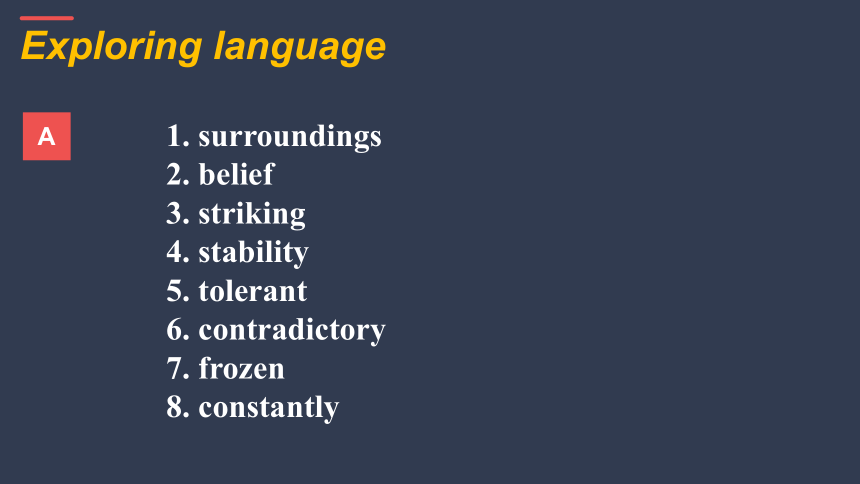
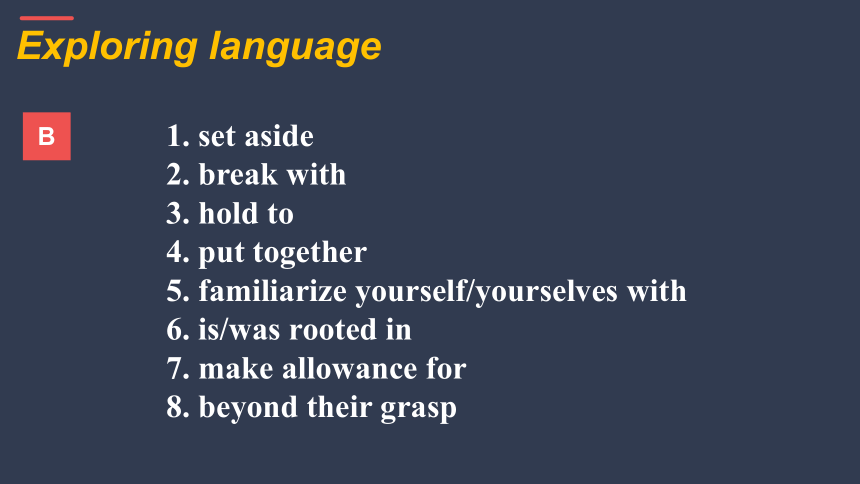
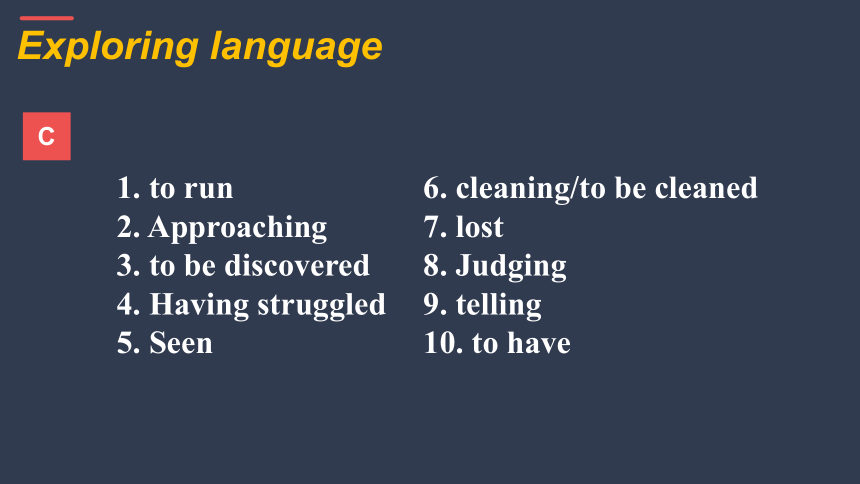
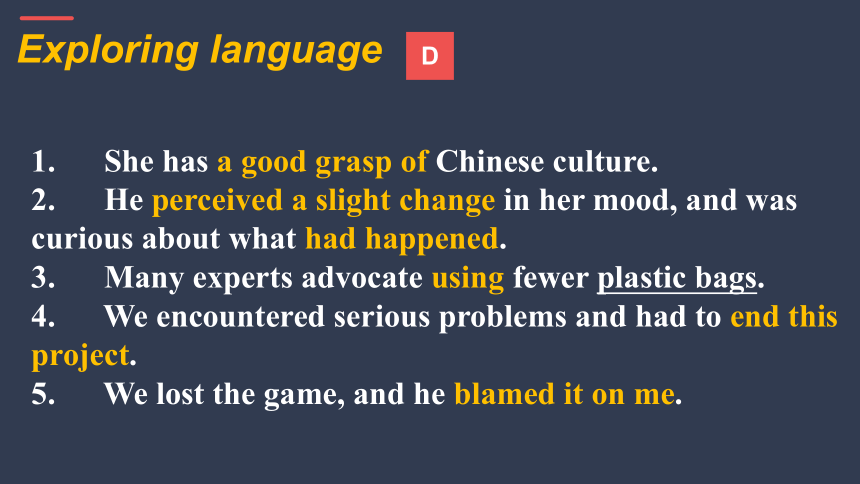

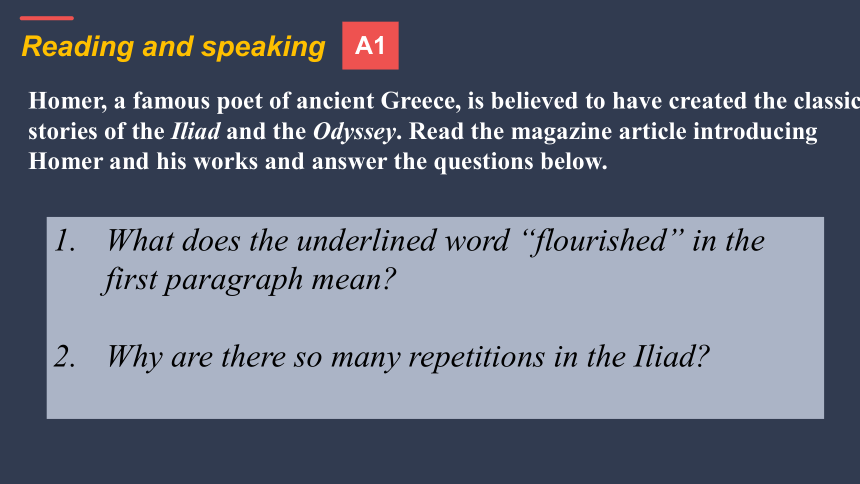
文档简介
(共19张PPT)
B4 U4
Workbook Answer Key
Exploring language
A
1. surroundings
2. belief
3. striking
4. stability
5. tolerant
6. contradictory
7. frozen
8. constantly
Exploring language
B
1. set aside
2. break with
3. hold to
4. put together
5. familiarize yourself/yourselves with
6. is/was rooted in
7. make allowance for
8. beyond their grasp
Exploring language
C
1. to run
2. Approaching
3. to be discovered
4. Having struggled
5. Seen
6. cleaning/to be cleaned
7. lost
8. Judging
9. telling
10. to have
Exploring language
D
1. She has a good grasp of Chinese culture.
2. He perceived a slight change in her mood, and was curious about what had happened.
3. Many experts advocate using fewer plastic bags.
4. We encountered serious problems and had to end this project.
5. We lost the game, and he blamed it on me.
Exploring language
D
6. The room has a secret exit that is really hard to detect.
7. They arrived at a small island far away from the Scottish coast.
8. This country has undergone enormous changes recently.
9. This novel is representative of his writing style.
10. His paintings are characterized by bright colours.
Reading and speaking
A1
Homer, a famous poet of ancient Greece, is believed to have created the classic stories of the Iliad and the Odyssey. Read the magazine article introducing Homer and his works and answer the questions below.
What does the underlined word “flourished” in the first paragraph mean
Why are there so many repetitions in the Iliad
A1
Homer, a famous poet of ancient Greece, is believed to have created the classic stories of the Iliad and the Odyssey. Read the magazine article introducing Homer and his works and answer the questions below.
1. What does the underlined word “flourished” in the first paragraph mean
“Flourish” means to develop quickly and become successful.
Reading and speaking
A1
Homer, a famous poet of ancient Greece, is believed to have created the classic stories of the Iliad and the Odyssey. Read the magazine article introducing Homer and his works and answer the questions below.
2. Why are there so many repetitions in the Iliad
There are many repetitions in the Iliad because the epic grew out of an oral tradition. The bards travelled from place to place, singing the stories from memory, and repetitions made it easier to remember the phrases, lines and sections and keep the stories going. Besides, the bards “borrowed” ideas from each other and, in time, their verses became more and more alike.
Reading and speaking
B1
The timeline of events in Robert Burns’s life
1759 Robert Burns was born in Ayrshire, Scotland.
(1) _______ Robert Burns started writing poems.
(2) _______ Robert Burns’s father died.
1786 Robert Burns published his first book of poetry.
(3) _________ Robert Burns began working as a tax collector.
(4) _________ Robert Burns passed away.
Robert Burns is considered to be the national poet of Scotland. Listen to the radio programme introducing Robert Burns and complete the notes below.
1774
1784
1789
1796
Listening and writing
B1
Robert Burns is considered to be the national poet of Scotland. Listen to the radio programme introducing Robert Burns and complete the notes below.
Poetic achievements
He became famous across the nation after the publication of Poems, Chiefly in the Scottish Dialect.
He is regarded as a(5) ______________ of the Romantic movement.
He also collected, revised and adapted(6) __________ from across Scotland into poems.
pioneer
folk songs
Listening and writing
Listening and writing
B2
Robert Burns’s poetry
“A Red, Red Rose”
It was written in Scots, a language spoken in Scotland, and is full of (1) ______________.
The poet expresses his love by describing melting rocks and (2) ___________________.
In the second half of the radio programme, the host interviews and expert on Robert Burns. Listen to the interview and complete the notes below.
emotion
the sea running dry
Listening and writing
B2
“Address to a Haggis”
In it, Burns (3) __________________for this traditional Scottish dish.
It is read when the haggis is served on Burns Night, the evening of (4) ___________________.
expressed his love
25 January
“Auld Lang Syne”
Burns wrote it based on (5) _______________________.
The poem is about friendship and remembering old times.
Singing “Auld Lang Syne” has become an important New Year’s Eve tradition across the(6) _______________ world.
a traditional Scottish song
English-speaking
Listening and writing
B3
Write an article introducing your favourite poet and his or her major works. You can include information about his or her life, poems and influences.
Title:______________
_______________________________________________
_______________________________________________
_______________________________________________
_______________________________________________
_______________________________________________
_______________________________________________
_______________________________________________
______________________________________________________________________________________________
Who your favourite poet is
Why you like the poet
Conclusion
Possible answer
B3
Possible answer
B3
Possible answer
B3
Guided reading
The change of seasons is a common theme in art and poetry, and these two poems are about spring. While both poems deal with the topic in a descriptive rather than metaphorical manner, they approach it very differently: the former depicts a quiet, rainy spring night, whereas the latter describes a joyous spring day.
“Happy Rain on a Spring Night” was written by Du Fu (712 — 770) in the year 761. At the time, he was living in Jin’guancheng (present-day Chengdu). Rather than expressing the poet’s feelings, the focus of the poem is on describing a rainy night-time scene:
“With wind it steals in night; / Mute, it moistens each thing.” This poem has a soft and subtle quality: there are no people to be seen, only the rain, the dark clouds and the dim light from a lantern on a boat. With the last two lines comes a shift in light and colour: “Dawn sees saturated reds; / The town’s heavy with blooms.”
“Written in March” is a poem by William Wordsworth, one of the great English poets of the Romantic era. It was written in 1802 in the beautiful Lake District of north-west England. There is an almost childlike joy in this poem: the short lines provide a rapid stream of springtime imagery. Where other poets would have used more elegant language, Wordsworth instead employed brave simplicity to achieve a stunning effect. There are hardly any similes or metaphors in this poem. One exception is when Wordsworth compares the remaining snow to an army that has lost a battle and is retreating: “Like an army defeated / The snow hath retreated”.
B4 U4
Workbook Answer Key
Exploring language
A
1. surroundings
2. belief
3. striking
4. stability
5. tolerant
6. contradictory
7. frozen
8. constantly
Exploring language
B
1. set aside
2. break with
3. hold to
4. put together
5. familiarize yourself/yourselves with
6. is/was rooted in
7. make allowance for
8. beyond their grasp
Exploring language
C
1. to run
2. Approaching
3. to be discovered
4. Having struggled
5. Seen
6. cleaning/to be cleaned
7. lost
8. Judging
9. telling
10. to have
Exploring language
D
1. She has a good grasp of Chinese culture.
2. He perceived a slight change in her mood, and was curious about what had happened.
3. Many experts advocate using fewer plastic bags.
4. We encountered serious problems and had to end this project.
5. We lost the game, and he blamed it on me.
Exploring language
D
6. The room has a secret exit that is really hard to detect.
7. They arrived at a small island far away from the Scottish coast.
8. This country has undergone enormous changes recently.
9. This novel is representative of his writing style.
10. His paintings are characterized by bright colours.
Reading and speaking
A1
Homer, a famous poet of ancient Greece, is believed to have created the classic stories of the Iliad and the Odyssey. Read the magazine article introducing Homer and his works and answer the questions below.
What does the underlined word “flourished” in the first paragraph mean
Why are there so many repetitions in the Iliad
A1
Homer, a famous poet of ancient Greece, is believed to have created the classic stories of the Iliad and the Odyssey. Read the magazine article introducing Homer and his works and answer the questions below.
1. What does the underlined word “flourished” in the first paragraph mean
“Flourish” means to develop quickly and become successful.
Reading and speaking
A1
Homer, a famous poet of ancient Greece, is believed to have created the classic stories of the Iliad and the Odyssey. Read the magazine article introducing Homer and his works and answer the questions below.
2. Why are there so many repetitions in the Iliad
There are many repetitions in the Iliad because the epic grew out of an oral tradition. The bards travelled from place to place, singing the stories from memory, and repetitions made it easier to remember the phrases, lines and sections and keep the stories going. Besides, the bards “borrowed” ideas from each other and, in time, their verses became more and more alike.
Reading and speaking
B1
The timeline of events in Robert Burns’s life
1759 Robert Burns was born in Ayrshire, Scotland.
(1) _______ Robert Burns started writing poems.
(2) _______ Robert Burns’s father died.
1786 Robert Burns published his first book of poetry.
(3) _________ Robert Burns began working as a tax collector.
(4) _________ Robert Burns passed away.
Robert Burns is considered to be the national poet of Scotland. Listen to the radio programme introducing Robert Burns and complete the notes below.
1774
1784
1789
1796
Listening and writing
B1
Robert Burns is considered to be the national poet of Scotland. Listen to the radio programme introducing Robert Burns and complete the notes below.
Poetic achievements
He became famous across the nation after the publication of Poems, Chiefly in the Scottish Dialect.
He is regarded as a(5) ______________ of the Romantic movement.
He also collected, revised and adapted(6) __________ from across Scotland into poems.
pioneer
folk songs
Listening and writing
Listening and writing
B2
Robert Burns’s poetry
“A Red, Red Rose”
It was written in Scots, a language spoken in Scotland, and is full of (1) ______________.
The poet expresses his love by describing melting rocks and (2) ___________________.
In the second half of the radio programme, the host interviews and expert on Robert Burns. Listen to the interview and complete the notes below.
emotion
the sea running dry
Listening and writing
B2
“Address to a Haggis”
In it, Burns (3) __________________for this traditional Scottish dish.
It is read when the haggis is served on Burns Night, the evening of (4) ___________________.
expressed his love
25 January
“Auld Lang Syne”
Burns wrote it based on (5) _______________________.
The poem is about friendship and remembering old times.
Singing “Auld Lang Syne” has become an important New Year’s Eve tradition across the(6) _______________ world.
a traditional Scottish song
English-speaking
Listening and writing
B3
Write an article introducing your favourite poet and his or her major works. You can include information about his or her life, poems and influences.
Title:______________
_______________________________________________
_______________________________________________
_______________________________________________
_______________________________________________
_______________________________________________
_______________________________________________
_______________________________________________
______________________________________________________________________________________________
Who your favourite poet is
Why you like the poet
Conclusion
Possible answer
B3
Possible answer
B3
Possible answer
B3
Guided reading
The change of seasons is a common theme in art and poetry, and these two poems are about spring. While both poems deal with the topic in a descriptive rather than metaphorical manner, they approach it very differently: the former depicts a quiet, rainy spring night, whereas the latter describes a joyous spring day.
“Happy Rain on a Spring Night” was written by Du Fu (712 — 770) in the year 761. At the time, he was living in Jin’guancheng (present-day Chengdu). Rather than expressing the poet’s feelings, the focus of the poem is on describing a rainy night-time scene:
“With wind it steals in night; / Mute, it moistens each thing.” This poem has a soft and subtle quality: there are no people to be seen, only the rain, the dark clouds and the dim light from a lantern on a boat. With the last two lines comes a shift in light and colour: “Dawn sees saturated reds; / The town’s heavy with blooms.”
“Written in March” is a poem by William Wordsworth, one of the great English poets of the Romantic era. It was written in 1802 in the beautiful Lake District of north-west England. There is an almost childlike joy in this poem: the short lines provide a rapid stream of springtime imagery. Where other poets would have used more elegant language, Wordsworth instead employed brave simplicity to achieve a stunning effect. There are hardly any similes or metaphors in this poem. One exception is when Wordsworth compares the remaining snow to an army that has lost a battle and is retreating: “Like an army defeated / The snow hath retreated”.
同课章节目录
- Unit 1 Food matters
- Welcome to the unit
- Reading
- Grammar and usage
- Integrated skills
- Extended reading
- Project
- Unit 2 The Universal Language
- Welcome to the unit
- Reading
- Grammar and usage
- Integrated skills
- Extended reading
- Project
- Unit 3 The art of painting
- Welcome to the unit
- Reading
- Grammar and usage
- Integrated skills
- Extended reading
- Project
- Unit 4 Exploring poetry
- Welcome to the unit
- Reading
- Grammar and usage
- Integrated skills
- Extended reading
- Project
